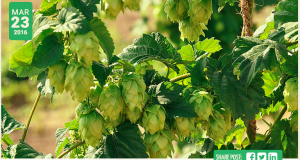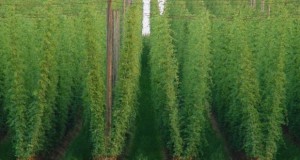How to measure moisture levels in hops and determine when they have been dried enough to prevent spoilage.
By: Diane Brown | Michigan State University Extension | Sept 16, 2013
While growing hops can be a challenge, properly processing them is even more so. If this is your first time harvesting, remember that the processing clock is ticking from the moment your hops are picked. You need to cut the bines, pick the cones and begin the drying process as soon as possible. Hops are generally dried down to between 8 to 10 percent moisture to prevent spoilage. Avoid over drying (6 percent or less) as over-dried hops shatter and lose quality. Hops that have been insufficiently dried will begin to oxidize, or turn brown, and will become musty smelling and moldy.
Drying hops is mostly science and partly art. For new growers or growers who are starting to work with equipment for drying hops, it helps to rely more on science to calculate the moisture level of hops. Hops that have just been harvested contain high levels of moisture (around 76 to 84 percent) that need to be lowered to 8 to 10 percent before hops are packaged and stored.
First, you will need to collect a sample of freshly harvested hops, weigh them, and dry them down to 0 percent moisture (bone-dry) to find out the original moisture level. A scale that is capable of measuring weights down to tenths of a gram is helpful. Use a mesh bag like the kind used to package onions and a paper tag to record variety name, row or block and fresh sample weight to help you identify the sample once it has been dried. Record the weight of the bag and tag on the tag so you know how much weight to subtract from the dried sample to determine the weight of the hops alone. Place the sample in the mesh bag, staple the tag to the bag and loosely tie it closed. Be sure to allow enough space in the bag for the sample to remain relatively flat in the bag.
Although an oven or a microwave can be used for drying the samples, a food dehydrator is probably the safest tool to use. Set the food dehydrator between 120 to 140 degrees overnight. Weigh the sample several times during the drying period until the weight doesn’t decrease any more. At this point, the moisture level should be 0 percent or bone-dry. Record the dried weight minus the bag and tag. The difference is the weight loss due to moisture.
Using an oven or a microwave requires closer and more careful watching or you risk burning the samples, or in the case of a microwave, causing damage to it. Use an oven thermometer to verify the temperature of the oven. Keep the oven setting low (oven dry the samples at 120 to 140) and check the samples frequently to prevent burning. Michigan State University Extension does not recommend using a microwave oven for drying hop samples due to the small size of the samples. When there is food in the oven, a large fraction of the output of the microwave transmitter is absorbed by it. Using a microwave oven to dry the small sample sizes typically used for calculating bone-dry weights can cause the oven to overheat and damage the magnetron.
Now that you have defined the bone-dry weight of the hops, you need to calculate the weight of the hops when they have reached 8 to 10 percent moisture. Once the targeted weights are known, the information can be used to determine when kiln dried hops are dry enough for packaging and processing. Prepare a sample of hops that can be easily removed from the kiln for weighing – this is the “kiln sample.” The weight of the kiln sample will be used to determine when the entire batch of hops has reached the desired moisture content. The sample can be put in a mesh onion bag as in our example before. This sample needs to be weighed before drying starts and it will be weighed throughout the drying process. Be sure to note the weight of the bag and any identification tag and subtract it from the weight so you are measuring only the weight of the hops.
Put the kiln sample in the middle of your drying apparatus rather than on an edge where it may dry more quickly than the rest of the hops. If you don’t want to do the math yourself, a hop harvest moisture calculator was developed by the University of Vermont hops program. Use the calculator and lookup table to determine the weight of the kiln sample when it has reached the target moisture level. When your sample has reached that target, drying is finished. If you are curious about how the target range for moisture is calculated, examples are given below.
Examples of percent moisture calculation
For simplicity, we will start with a wet hop sample of 100 grams including the bag and tag. The bag and tag alone weigh 5 grams. After drying, the sample – including bag and tag – weighs 25 grams. We need to subtract the weight of the bag and tag which we determined as 5 grams.
Dried weight (0 percent moisture): 25 grams – 5 grams for bag and tag = 20 grams
1 – [(dried weight/wet weight) x 100] = percent moisture
In our example, 1 – [(20/100) x 100] = 80 percent moisture
Calculation of weight based on target moisture percentage
To get within the targeted range of moisture (8 to 10 percent), we need to calculate the weight needed with desired percent moisture. To do this, take the dry weight/[1-(percent moisture desired/100)] = the targeted weight
In our example, we are targeting 10 percent moisture and use our dried sample weight of 20 grams.
20 g/[1 – (10/100)] = 20 g/(1-.1)= 20 g/0.9 = 22.2 grams is the target weight
In our example for 8 percent moisture, using our dried sample weight of 20 grams:
20 g/[1 – (8 percent/100)] = 20 g/(1 – .08) = 20 g/0.92 = 21.7 grams
So for a dried sample of hops within the range of 8 to 10 percent moisture, our original 100 gram sample should weigh between 21.7-22.2 grams.
The kiln we use to dry the hops from the research plots at the Southwest Michigan Research and Extension Center has a series of removable drawers with wooden frames and metal mesh bottoms that allow airflow. We place a kiln sample bag in the center of each one of the drawers when drying. An information wiki on constructing a similar hop drying oast (kiln) was developed by the University of Vermont hop program.
What can you expect for yields of dried hops? As an example, 4.6 pounds of fresh hops harvested at 80 percent moisture (determined on a separate sample) will dry to 1 pound of hops at 8 percent moisture. Hops do not dry evenly and should be allowed to sit for a few hours, conditioned, before packaging to allow the remaining moisture to redistribute and become equalized.
 Ontario Hop Growers' Association The OHGA is a not-for-profit association of hop growers, families and enthusiasts who are interested in supporting the growth of the hop industry in Ontario.
Ontario Hop Growers' Association The OHGA is a not-for-profit association of hop growers, families and enthusiasts who are interested in supporting the growth of the hop industry in Ontario.



